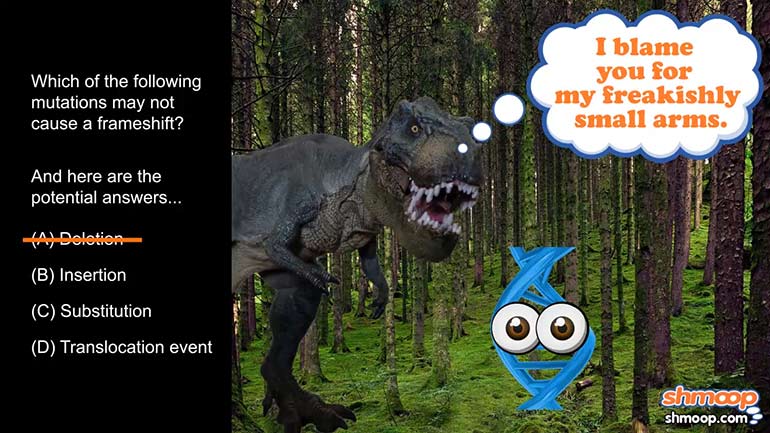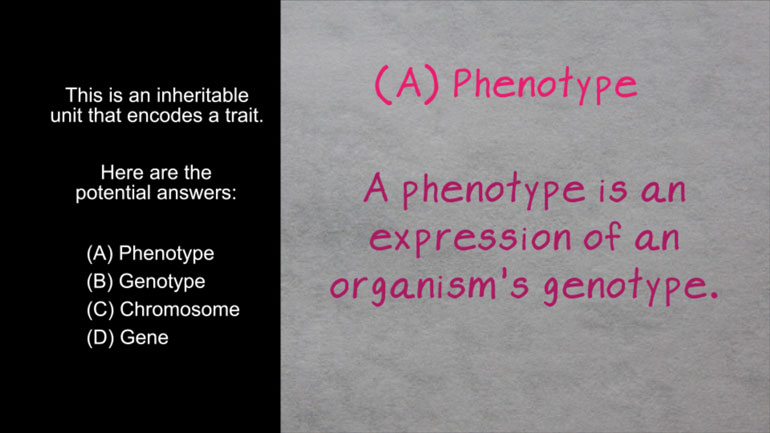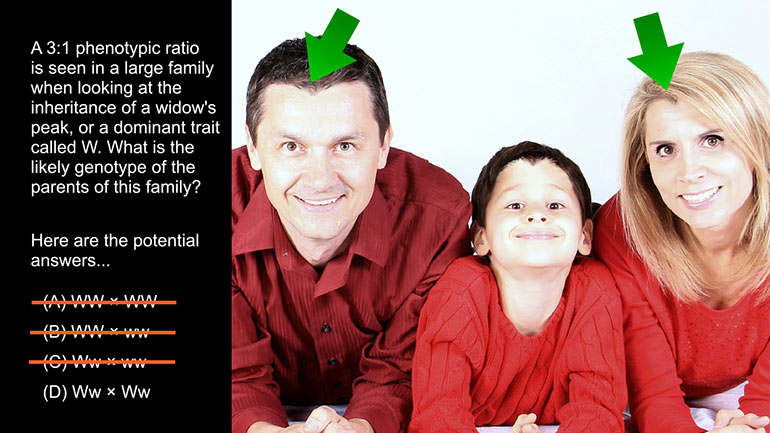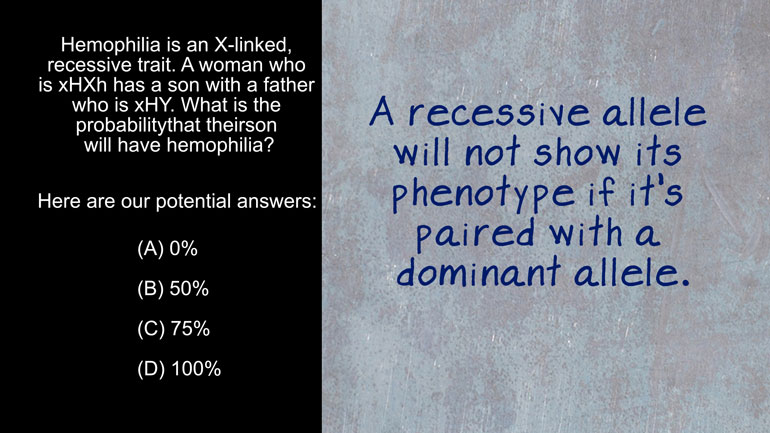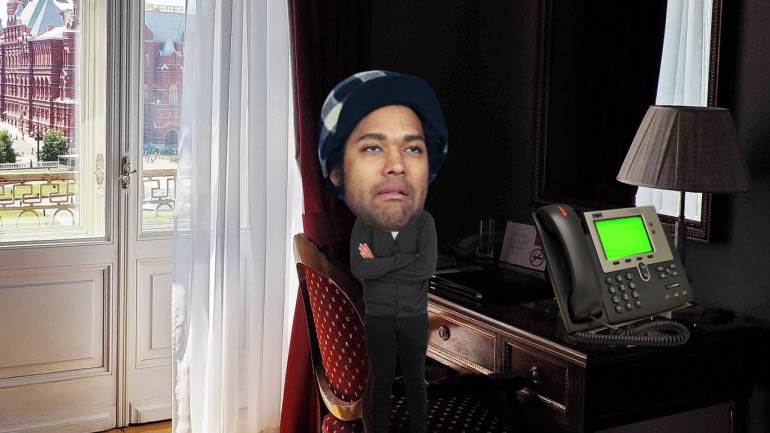ShmoopTube
Where Monty Python meets your 10th grade teacher.
Search Thousands of Shmoop Videos
Essential Life Process Information Videos 11 videos
AP Biology: Essential Life Process Information Drill 1, Problem 1. If one parent is heterozygous for the sickle cell trait while the other par...
AP Biology 1.5 Essential Life Process Information. Which of the following mutations may not cause a frameshift?
AP Biology 1.3 Essential Life Process Information. Which is an inheritable unit that encodes a trait?
AP Biology 2.3 Essential Life Process Information 9 Views
Share It!
Description:
AP Biology 2.3 Essential Life Process Information. What percentage of the DNA would one expect to have radioactive nitrogen?
Transcript
- 00:04
And here's your Shmoop du jour brought to you by radioactive nitrogen.
- 00:08
So uh…maybe don't get too close to the screen. [Man sitting watching television and grows an extra head]
- 00:10
We don't want to be responsible for any extra heads this video may cause…
- 00:14
Okay, here's our question…
- 00:16
Cells were given radioactive nitrogen so that their entire DNA became radioactively labeled.
Full Transcript
- 00:21
The cells were then given non-radioactively labeled nitrogen and allowed to replicate
- 00:25
by binary fission.
- 00:26
A sample was taken at this point to quantify what percentage of DNA was radioactively labeled.
- 00:32
What percentage of the DNA would one expect to have radioactive nitrogen?
- 00:36
And here are our answers…
- 00:40
Have you heard of the phrase, “you are what you eat?” [Man eating an apple and a man made from apples appears beside him]
- 00:42
It's actually pretty true…
- 00:43
…At the atomic level, that is.
- 00:45
We don't see a lot of people walking around made of burritos, which is good…no one wants [Burrito's walking and bump into each other]
- 00:49
an uptick in the cannibal population.
- 00:52
In this question, cells were fed radioactive nitrogen, which if we're not mistaken, is [A cell eating radioactive nitrogen]
- 00:57
the start of almost every cell-based superhero movie.
- 01:00
The way it behaves in the cell is basically the same, but since it’s radioactive, scientists [A superhero cell wearing a red cape]
- 01:04
can keep track of where it goes among all the other nitrogen found in the cell.
- 01:09
In this question, the researchers feed the cells with 100% radioactive nitrogen, which [Scientist feeding a cell radioactive nitrogen]
- 01:13
means that all of the nitrogen in the cell will have this special nitrogen label.
- 01:18
That's also why these cells need to adopt an alter-ego in their crime fighting lifestyle.
- 01:22
And since DNA is made of nitrogen, all the nitrogen in the DNA will be radioactively [Nitrogen in a DNA helix radioactively labeled]
- 01:27
labeled.
- 01:28
Now, when the cells are allowed to divide, they're fed nitrogen that doesn’t have the
- 01:31
special radioactive sauce, which we think might be the same stuff put in A1...
- 01:36
So basically, this unlabeled nitrogen won’t give off any signal when incorporated into
- 01:41
the cell.
- 01:42
So the question is, what happens to the specially-labeled DNA when binary fission occurs? [A man fishing]
- 01:47
A better question is, what the heck is binary fission?
- 01:50
Binary fission is when a single cell divides into two daughter cells. [A cell divides into two cells]
- 01:54
Imagine if when you grew up, you decided to split yourself in half…and then those halves
- 01:58
grew into two full versions of yourself.
- 02:00
That’s basically what binary fission is, except less painful and less…creepy. [Man splits in half and two identical people appear]
- 02:05
But what happens to the DNA when binary fission occurs?
- 02:08
Of course, both daughter cells need a full set of DNA. [daughter cells hold hands and walk away]
- 02:11
This means that before binary fission can occur, the cell must perform…
- 02:15
…The role of the Phantom in The Phantom of the Opera.
- 02:19
But after that's done, the cell has to perform DNA replication. [Cell replicating it's DNA]
- 02:22
When DNA replicates, the original DNA double helix separates, and DNA polymerase comes
- 02:26
in to add new bases to each single strand, resulting in TWO new helices. [DNA polymerase adding bases to two single strands of DNA and creates two new strands]
- 02:32
So going back to our original question, let’s imagine the parent DNA, completely labeled
- 02:36
with the radioactive nitrogen.
- 02:37
Now, when the cell is being fed with normal nitrogen and it prepares to divide, what happens
- 02:42
when DNA replication occurs?
- 02:45
Each daughter cell will get one strand of the parent’s original DNA, and one strand
- 02:49
that was freshly made by DNA polymerase. [DNA polymerase adding bases to two strands of DNA]
- 02:51
In this case, that means that each daughter will inherit one strand with the special sauce…mm,
- 02:56
A1… …which means that after one round of cell
- 02:59
division, 50% of the DNA will be radioactively labeled.
- 03:03
Which means our answer is C, 50%!
- 03:06
Which is coincidentally, our steak to A1 ratio. [Man eating steak with A1 sauce]
- 03:09
…More or less.
Related Videos
AP Biology: Biological System Interactions Drill 1, Problem 1. Complete the sentence about a saturated fatty acid.
AP Biology: Essential Life Process Information Drill 1, Problem 1. If one parent is heterozygous for the sickle cell trait while the other par...
AP Biology: Evolution Drives the Diversity and Unity of Life Drill 1, Problem 1. The first cells on planet Earth were likely what?
AP Biology: Free Energy and Molecular Building Blocks Drill 1, Problem 1. Which statement incorrectly describes the properties of water?
AP® Biology: Evolution Drives the Diversity and Unity of Life Drill 1, Problem 2. What was likely the first genetic material?

